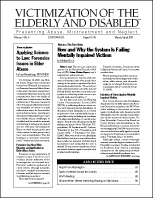“Home Invasion” Type Elder Abuse, Part II
Author: Roslyn Myers, J. D..; Jorge Jacobo, J.D..
Source: Volume 08, Number 04, November/December 2005 , pp.59-59(1)

< previous article |next article > |return to table of contents
Abstract:
This is the second of a multipart article that describes forms of elder abuse that are not always processed by the system, but are common in metropolitan areas where gangs and drugs are prevalent. As in many other cases of elder abuse, the victim’s trust of the perpetrator leads to the abuse. The victim allows the perpetrator to move in, to use his or her home, perhaps loans the abuser money, and eventually, the victim is no longer in control of his or her own life. Usually, the victim does not contact the police for any number of reasons: because she or he fears retaliation; feels embarrassed and responsible for having allowed the abusers to enter the home; or because the elderly person is a virtual prisoner to the perpetrators and the situation. In only one case did the relationship appear to be quid pro quo; the “perpetrator” used the “victim’s” home as a flophouse, and the “victim” used the “perpetrator” for sex. The victims’ failure to call for help makes these cases difficult to detect and nearly impossible to prosecute. Often, the most effective antidote is community intervention. In most cases, the police put a stop to the abuse only after community members reported the activity. Some cases are here summarized.Keywords: elder abuse where gangs and drugs are prominent
Affiliations:
.